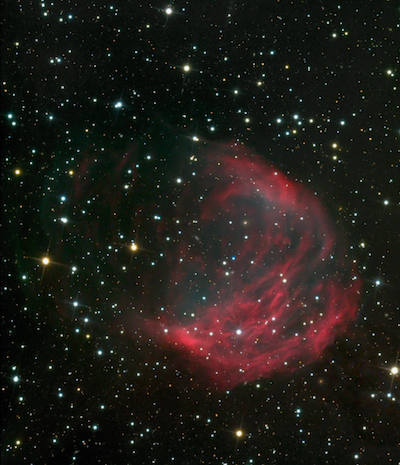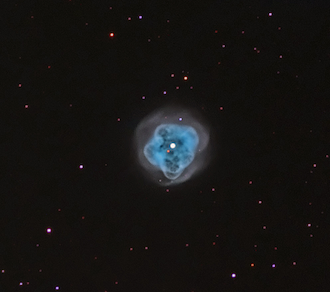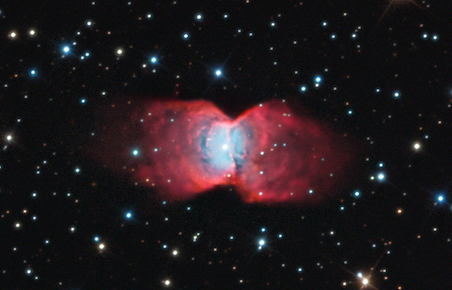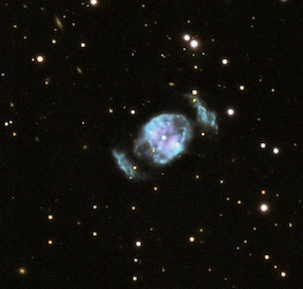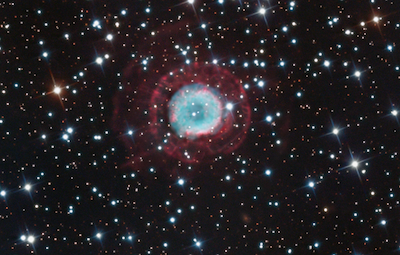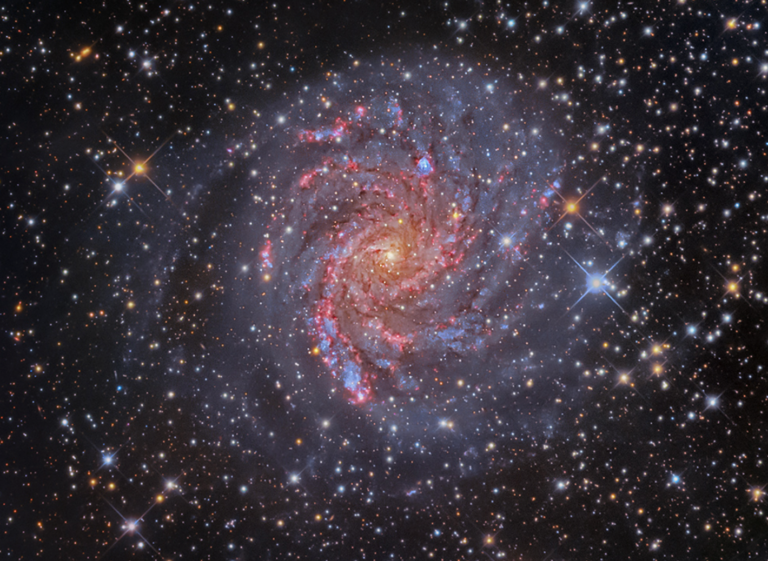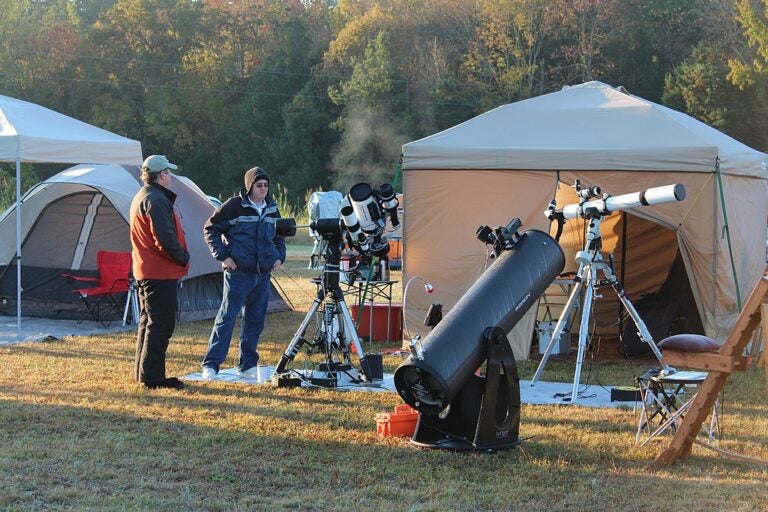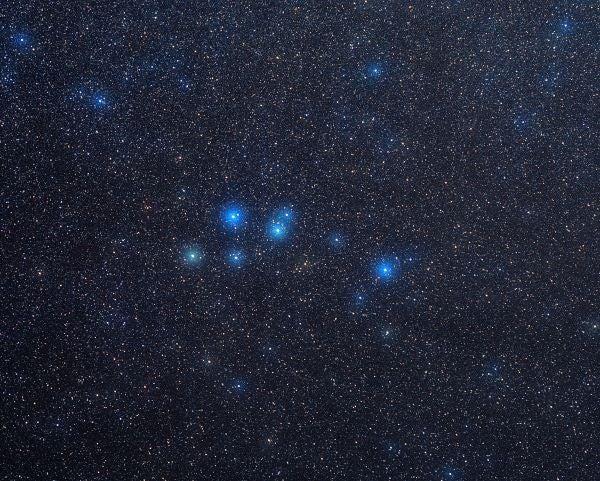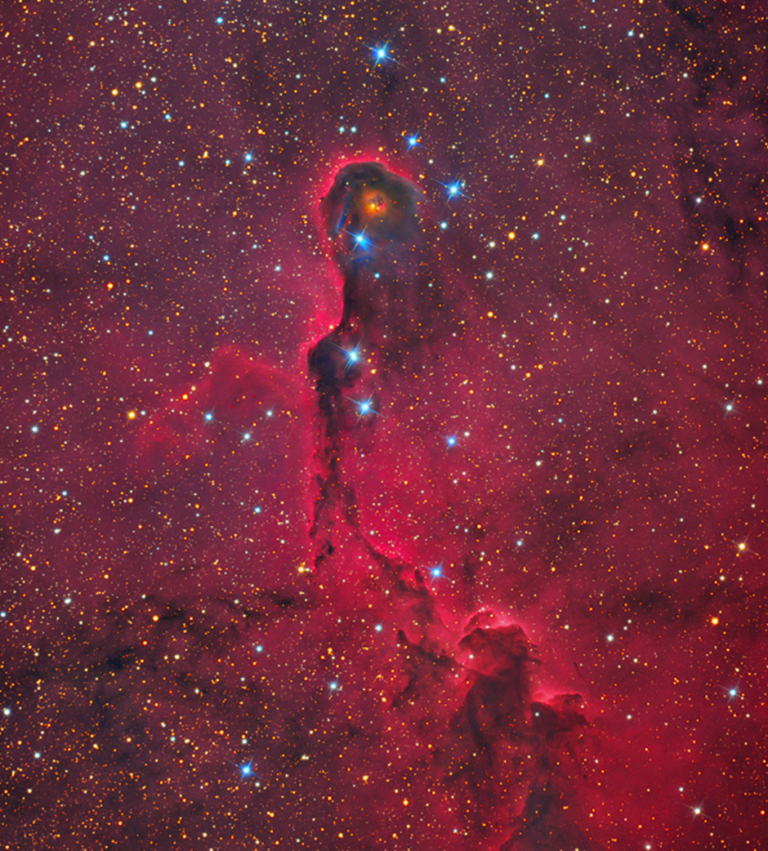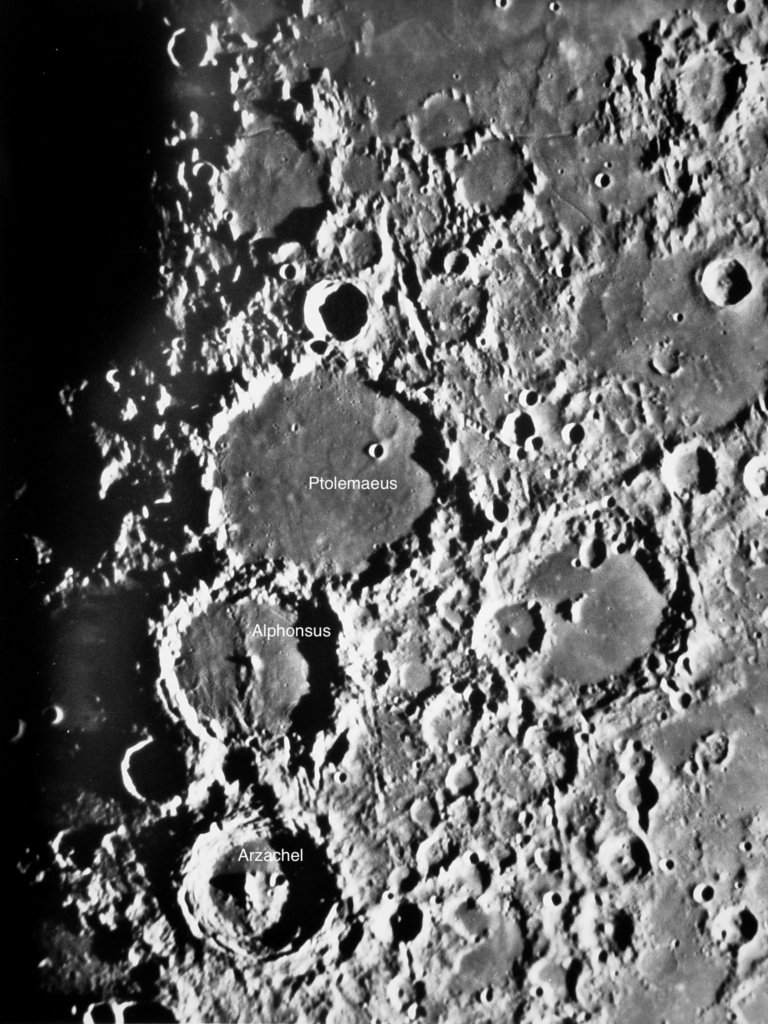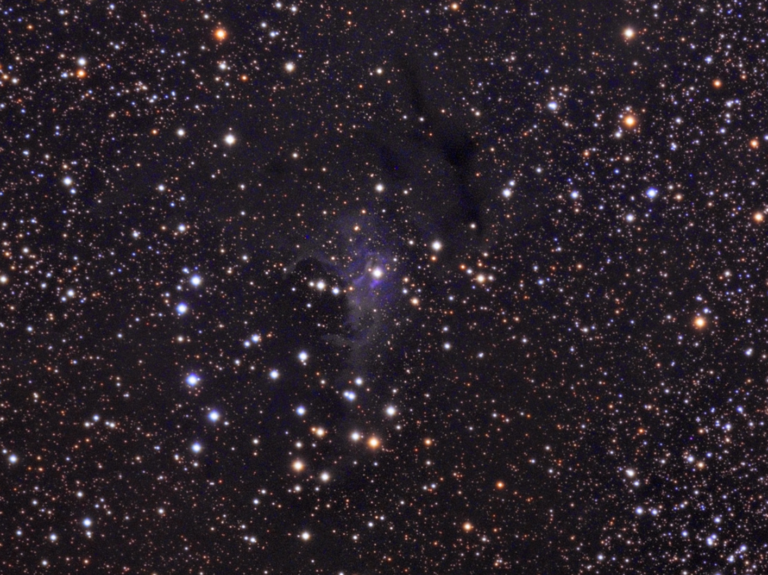(1,000–3,000 light-years)
We begin our journey about 3½˚ east-southeast of 3rd-magnitude Zeta (ζ) Persei, where we’ll peer into the crystal ball: NGC 1514, sometimes called the Crystal Ball Nebula. This 5,000-year-old “inside-out” planetary lies only 1,200 light-years distant and has a relatively bright (magnitude 9.4) central star. This is one of the few central stars we can see through binoculars. Clinging to it like static lint is a tediously dim shell spanning 2′ in diameter. The nebula’s discoverer, William Herschel, wrote in 1790: “The atmosphere is so diluted, faint and equal throughout that there can be no surmise of it consisting of stars, nor can there be a doubt of the evident connection between atmosphere and star.” I found the glow difficult to see in a 4-inch scope but apparent in a 5-inch instrument. Use moderate magnifications to reveal the inner shell’s delicate arcs, which are oriented northwest to southeast. Perpendicular to them are fainter elliptical lobes, like a flower just beginning to bloom.
To appreciate how age can affect the apparent size of a planetary nebula, try sighting Abell 21, the 8th-magnitude so-called Medusa Nebula in Gemini. Although the Medusa lies only 600 light-years farther away than NGC 1514, it appears 300 times larger because the shell around Abell 21’s 14th-magnitude central star has had nearly 30,000 years to expand! Through backyard telescopes, the 10′-wide glow is brightest along its eastern crescent. While an OIII filter will help pull it out from the background, I was able to spy it without a filter through my 8-inch reflector at moderate magnification by gently sweeping the area; seeing the extremely pale specter required intense concentration. Larger scopes will enhance the view, bringing out some of Medusa’s snaking gaseous “hairs.”
Moving to a distance of 2,900 light-years, we find a marvelous midland object: NGC 2346, the Crimson Butterfly. It lies about 4′ west-southwest of magnitude 4.5 Delta (δ) Monocerotis, and it’s hard to say how easy or difficult this object will be to see because its central star is the variable binary star system V651 Monocerotis. Usually, we see that star “flapping” between magnitude 10.5 and 11.5, making it a cinch to spy, but it may suddenly dip to magnitude 15 or fainter if a dark cloud in the torus of gas surrounding the central binary star moves across our line of sight. I’ve spied NGC 2346’s torus through a 5-inch under dark skies at magnifications of 150x and higher; the butterfly’s 50″ wings appear to open through my 8-inch scope. It’s taken some 11,000 years for the wings to flee from the central star and blow out from its wasp-waisted ring.
Now that you have a taste for the dramatic differences that age and distance can make on these objects, let’s plunge more deeply into the planetary pool.
(3,000–5,000 light-years)
On the other end of size spectrum, we have objects like IC 418, the Spirograph Nebula in Lepus the Hare. You’ll find this visually amenable pipsqueak about 5° east of Alpha (α) Leporis. It shines at 9th magnitude and can be spied in binoculars — only this time, you’re seeing its 10th-magnitude central star, as well as its highly compact main shell and crown. In fact, this spirograph of nebulous mayhem fills a disk only 14″ across! While it lies 3,900 light-years distant (about three times farther than NGC 1514), its disk appears 8.5 times smaller, partly because IC 418 is 2,000 years younger, so its shell has not expanded much. The nebula is a challenge to resolve. Powers of 500x and greater are required to get good separation between the star and shell.
Stepping out to 4,600 light-years, we find the 11th-magnitude peanut-shaped planetary NGC 2371–2. As with planetary nebula M76, its discoverer, William Herschel, resolved this single bipolar object into two parts, thus the double NGC number. The southwestern lobe is NGC 2371, and the northeastern one is NGC 2372. You’ll find it 1½° north of 4th-magnitude Iota (ι) Geminorum. While the full nebula (dim wings included) spans 58″, its bright core is smaller. I could spy the twin arcs of the central torus, divided by a clean dark lane, at 94x in a 5-inch scope, being oriented northwest to southeast, but the view is much better at 180x. Larger scopes are required to see the wings, which have taken 3,000 years to blow out. Use a magnification of 500x or more to search for the magnitude 14.8 central star.
(5,000–7,000 light-years)
Moving out to 5,000 light-years, we come to the magnitude 10.5 planetary IC 2149, near 2nd-magnitude Menkalinan (Beta [β] Aurigae). This celestial gnome visually resembles NGC 1514 in that its magnitude 11.3 central star dominates the view, but the comparison stops there. IC 2149’s nebula stretches a mere 8.5″ across, appearing as a knotty ring seen almost edge-on. And while this baby blue nebula is 40 percent the size of IC 418, it’s nearly 1.5 times as distant and 1,000 years younger; indeed, the nebula also sports youthful mini-bipolar lobes caught in the process of formation. You’ll want to crank up the power to see this one, but use low power to spy its gentle color.
Now let’s hop a mere 200 light-years farther into space to inspect NGC 7354, a 12th-magnitude celestial introvert. It hides inconspicuously just outside the House of Cepheus asterism, about 31⁄4° north-northeast of Delta Cephei. With a diameter of 22″, the nebula has a 3,000-year-old clumpy oval main shell and an older circular outer shell. In the image at right, note the collection of low-excitation bright knots in its equatorial torus. Isn’t it reminiscent of IC 2149? I found the nebula apparent in a 5-inch scope at 60x as a tight and diffuse glow with a bright core and a small outer halo. The annulus opens at magnifications of 180x and more, showing the outer nebula as an egg-shaped glow with a beaded inner ring. The central star glows weakly at magnitude 16.2.
NGC 2440, the Albino Butterfly, is one of the most beautiful planetaries of its kind. At a distance of about 6,200 light-years, this 9th-magnitude beauty is situated about 4½° due south of open star cluster M46 in Puppis, roughly midway between the two preceding planetaries. So within the span of 200 light-years, try to appreciate the subtle differences in each. The butterfly sports an oval torus (with two distinct condensations) and three pairs of white bipolar polyps (the wings) emerging at different places from the nebula’s core. The wings extend farther (30″) than NGC 7354’s partly because of its greater age (7,000 years) and closer distance. As with NGC 7354, its high-excitation central star is extremely dim, shining around 18th magnitude. Visible through a 4-inch scope, the bright central shell displays knots and filamentary details that flutter in and out of view with the seeing; the wings are dim extensions that taper like the flame of a candle.
It’s also fun to visually compare the Albino Butterfly with the multiple-shell planetary nebula NGC 2438, which we see projected against M46 in a marvelous chance alignment. By comparison, NGC 2438 lies some 1,600 light-years closer, shines about 1½ magnitudes fainter, and appears about 40″ larger — again, partly because of its closer distance, as well as its 12,000-plus-year expansion age for its main shell.
(Beyond 7,000 light-years)
Here’s a challenge with three reasonable solutions. Abell 12, a peek-a-boo planetary that’s 37″ wide and magnitude 12.4, is dim enough and big enough to present a challenge on its own. But if we add that it lies only about 50″ northwest of 4th-magnitude Mu (μ) Orionis, the difficulty becomes obvious. The good news is you know exactly where to look; that’s one solution. Another solution: A magnification of 250x and above places a highway of darkness between the star and the planetary. The third solution is to use an OIII filter, which pops the nebula right out of the background while dimming the star some. Use an orthoscopic eyepiece with a narrow field of view, and you can nudge the star out of the way. I’ve spied it through a 4-inch scope this way. If you see it, you’re peering some 7,500 light-years into space.
Our last target is high on my favorite list of small-telescope challenges: IC 1747, the Holepunch Nebula. This 12th-magnitude denizen lies an impressive 8,400 light-years distant, yet it displays a disk 13″ across. It has the distinction of being only one of 50 planetaries known with a central star (usually a white dwarf) that displays the spectral characteristics of a Wolf-Rayet star (normally a highly evolved massive star) but somehow with a mass typical of most planetary central stars. It’s the dim specter of a ring in a rich Milky Way field about 30′ southeast of Epsilon (ε) Cassiopeiae in that constellation’s W asterism that stirs my heart, making it one of most delicate sights through a 5-inch. Astrophotographers should be aware that the ring has a fascinating string of knots west and southwest of the inner nebula, which might be part of a fragmentary halo.
Take some time this winter observing season to check out some of these stellar blowouts. They show us the future of the solar system, as one day our vicinity will end up in this chaotic, glowing fashion. They present beautiful shapes, and these glowing orbs remind us our Sun will not live forever. I think you’ll be challenged by some and delighted by others, and come away from the hunt a better, more experienced observer.

